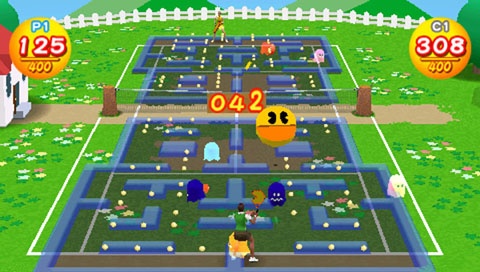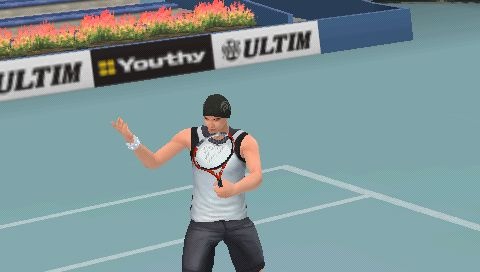The Smash Court Tennis series has been around in North America for almost 10 years. The games have always been good, but the franchise has never reached the same level of popularity as Virtua Tennis. Once again the two series are going head-to-head, this time on the PlayStation Portable. There's no shortage of ways to stay occupied in Smash Court Tennis 3, but the tennis itself is only passable and the pro tour mode is uninteresting after a few hours. Once again, Smash Court Tennis 3 seems destined to remain in second place.

The first thing you'll want to do after booting up Smash Court Tennis is go to the training mode, which is a no-frills way of teaching you the game's timing-based swing mechanic. It's functional, and you'll be a much better player for it. Once you've gotten the basics down, you have a number of ways to test your skills. You can play a tournament, start a career, or play a quick match. You can also play friends via ad hoc and even use game sharing. If you don't want to play a full match, you can play a few training minigames, though they're not particularly exciting. There are even a few arcade-style tennis variants. Pac-Man Tennis replaces the court with a maze: You try to hit dots with the ball, which is actually Pac-Man and not a ball at all. You're awarded a point for every dot you hit, as well as multipliers for getting fruit. Galaga Tennis places you in outer space and has you hitting the alien creatures that fly on the court. Bomb Tennis replaces the ball with a bomb and then drops bombs on the court when someone loses a point. The more bombs there are on the court, the bigger the explosion when the "ball" finally explodes. These three modes are interesting and a nice diversion if you're tired of playing normal tennis.
You'll probably spend most of your time in the pro tour, which is extremely similar to Virtua Tennis' career mode. You start off by creating a player using limited character-creation tools. Then you set off on a career with the goal of being the number one ranked player in the world taking on both fictional and real players. There are 16 pros in the game, including such big names as Sharapova, Federer, Nadal, Hingis, Blake, and Henin. The calendar is broken down into weeks, and you can choose whether you want to train. If your rank is high enough, you can enter a tournament. You'll need to rest every now and then to refill your stamina bar, which depletes a bit after each week's activity. After training, you're awarded points; after winning a match, you are awarded points, shop points, and money. You can buy new items such as new equipment and training modes with shop points. Regular points are used to increase your player's level, which is basically meaningless, but when your level increases, you receive another type of point. These points can be used to upgrade your player's abilities and even teach you player new shots. The whole system is convoluted and needlessly complex. It doesn't help that improving your player's skills typically doesn't yield tangible results. Sure, you'll notice the difference between a player just starting out and one that has been around for six months, but the difference from week to week or even month to month is negligible. The whole pro tour mode is functional, but it's just not that interesting after a few hours.
On the court, Smash Court 3 is a lot like Jim Courier: It's solid and technically sound but far from amazing. You've got the typical array of shots at your disposal, but unlike many games, drop shots can be quite effective, which is nice. For some reason, the ball tends to stay in the middle of the court, so there's very little action on the sidelines. Because the ball is rarely going to be out of reach to your left or right, rushing the net is a very effective tactic. It's often the only way to finish points because otherwise matches tend to drag on forever. The game finds a nice level of challenge, never getting too hard and never too easy. Unfortunately, it achieves this balance in a very artificial way. Sometimes both you and the CPU will hit the ball even when it clearly didn't touch your racket. Sometimes your player won't swing at the ball, even when you're pressing a button. Obviously you can't tell if the CPU intended to hit a ball if you don't see it swing, but judging by how it will just watch balls go by right at its feet, it feels like something's not quite right.

Smash Court's visuals match up with the rest of the game: They're functional and get the job done. There are a number of hard, grass, or clay courts, each with a unique look and feel. Player models are decent, but other than a few cutscenes, you won't see them up close. The frame rate is solid and never an issue. One thing that is an issue, however, is the camera. It's far away from the court, which isn't a problem, but it's at an angle that makes it impossible to see your opponent's racket and the ball when he or she serves, which makes it difficult to return hard serves. You also can't see your opponent's racket and the ball when he or she goes to smash the ball, so you have no way of knowing where the ball is going. The optional lower-angle camera is much friendlier and also shows off the player models better, so it's odd that it's not the default camera. The game's audio is universally poor. Both the crowd and the announcer sound like low-fidelity samples. They're also quite often late reacting to the action.
The biggest problem with Smash Court Tennis 3 is that it doesn't really do anything that the two Virtua Tennis games on the PSP don't already do better. The arcade-style minigames are fun and the pro-tour mode is decent, but there's little reason to give the game a look when there are other, better options available.